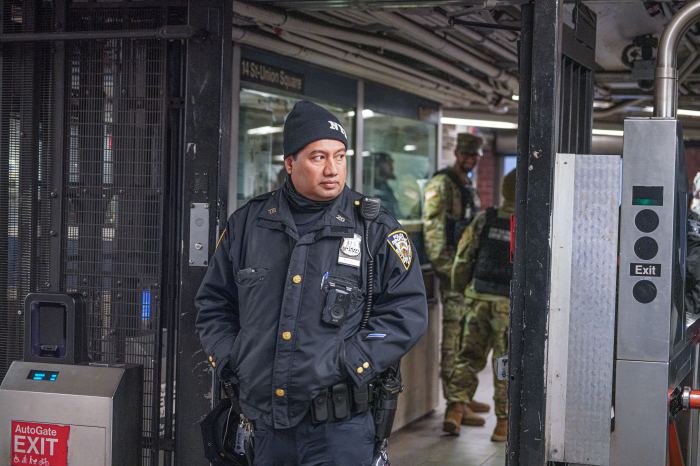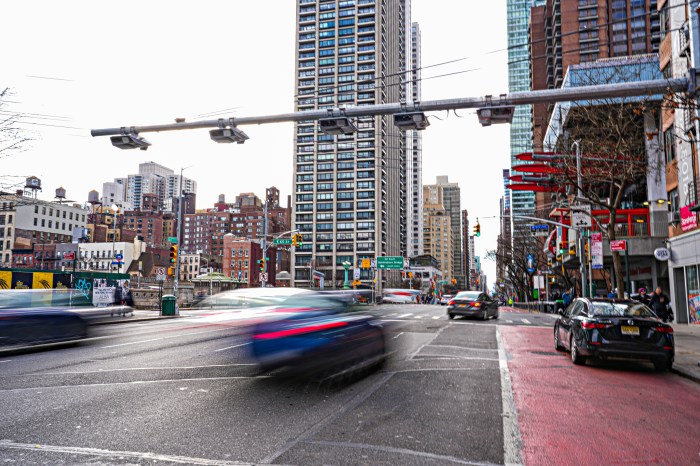
The Brooklyn-Queens Expressway is about to get even more unpleasant.
The city on Thursday unveiled two disruptive options to replace a 1.5-mile stretch of the loathed highway from Atlantic Avenue to Sands Street that has reached a state of unmanageable deterioration.
With the highway tucked between Brooklyn Heights and popular waterfront park space — and above several subway tunnels — the city is left with no choices that won’t significantly impact the nearby scenic promenade, residents or a chunk of the 153,000 drivers who rely on the span each day, according to Polly Trottenberg, the commissioner of the city’s Department of Transportation.
“The challenge we face is how really to completely replace, rehabilitate this aging obsolete structure while trying not to create just terribly difficult, nightmarish traffic scenarios for not only Brooklyn — Brooklyn, Queens, Staten Island,” Trottenberg told reporters at a briefing. “I mean, really, this highway has such an impact on the traffic system almost in the entire city.”
The city is also under pressure to swiftly carry out this “epic challenge,” according to Trottenberg. The roadways are degraded to the point that the city would have to institute weight restrictions on the highway by about 2026, diverting trucks off the stretch of roadway and onto local streets.
DOT will begin community outreach immediately. The first public meeting will take place Thursday, Sept. 27, at the Ingersoll Houses Community Center, 177 Myrtle Ave., Brooklyn. Doors open at 5:30 p.m.
The first rehabilitation option, an “innovative” approach that the DOT favors, would require the city to build a completely new, temporary elevated highway above the current roadways at the height of the promenade. Columns would be built along Furman Street to support the new structure, which would be six lanes — three in each direction — to serve all BQE traffic.
Contractors would then work underneath replacing the roadways.
The downside to this option is the closure of the Brooklyn Heights promenade for six years. But, “during that time, essentially, the traffic wouldn’t feel much of a difference during the daytime hours,” according to Tanvi Pandya, the DOT’s senior BQE programmer.
“We think there is a huge gain doing the elevated roadway,” she said, noting that this option will also allow for a 35-foot expansion of the promenade.
The option would take six years and cost between $3.2 and $3.6 billion.
The more traditional alternative would require the city to incrementally repair the roadway on a lane-by-lane basis with traffic patterns shifting more frequently. It would also require overnight construction — about 24 impactful weekend road closures and the removal of trees on the promenade.
This method, which would take at least eight years and cost between $3.4 and $4 billion, would make project completion less certain and traffic backups more likely because of the potential for complications during overnight work, Pandya said.
Besides getting new structures to last another century, the DOT hopes to take the opportunity to improve public space around the highway, including a unification of Van Voorhees Park; safety improvements to the Atlantic Avenue interchange and potentially constructing a pedestrian bridge from the Brooklyn Heights Promenade to Brooklyn Bridge Park.
As other cities around the world reduce the footprints of their highways, Trottenberg said she couldn’t see a time in the coming decades where the BQE wouldn’t exist as it does today. She slammed the Robert Moses-era highway for its “substandard” build “on the cheap.”
“I was at a break-fast last night with someone actually from the neighborhood who said, ‘Ugh, why can’t you just let it fall to the ground?,” Trottenberg said. “For better or for worse, these Moses-built highways … now the city has grown around them and it’s not an option to just say we can’t deal with that traffic.”
She added that delivery constraints also play a role.
“One of our challenges, right, is we have a city that gets almost all our freight via truck,” she added. “We are not well connected to the mainland with freight rail connection, which is how almost every other American city gets some amount of it’s freight.”

































